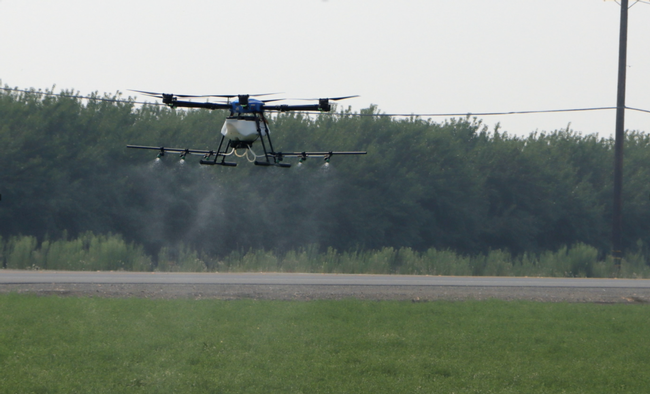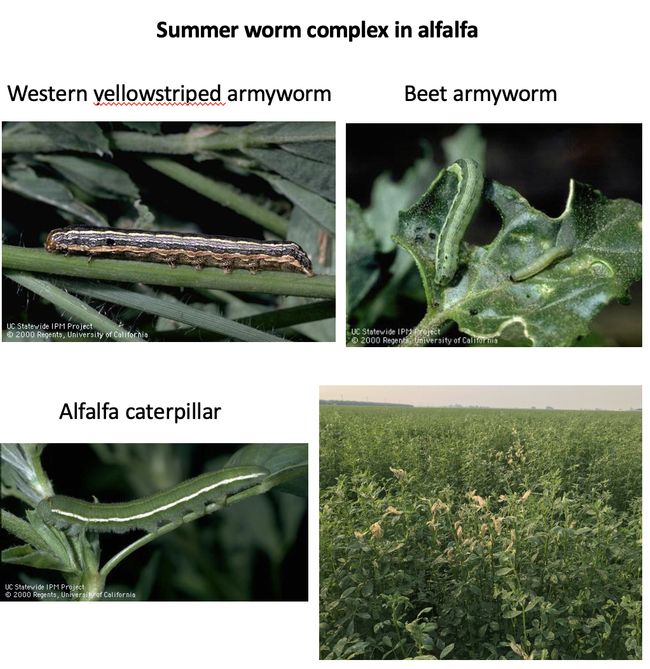Use of drones (UAVs, unmanned aerial vehicles) for aerial application of pesticides in agricultural crops is becoming a reality.
Drone technology provides an additional tool for growers to control pests and diseases on farms, supplementing traditional ground and aerial spraying practices. This could be especially helpful in areas where there's a shortage of farm labor for pesticide applications or for small areas that require spot treatment.
2020 Drone Trials
In the summer 2020, we evaluated the efficacy of drones compared to airplanes for applying insecticides for summer worm control in alfalfa hay fields (see photo 1). These pests can be highly damaging to alfalfa as the larvae feed on the foliage, causing significant losses in forage yield and quality if left uncontrolled (see photo 2, with alfalfa caterpillars and armyworms and plant damage). We conducted our trials in two alfalfa fields in Yolo Co., CA using the insecticide Prevathon® insect control (active ingredient: chlorantraniliprole). Fields were divided with one part sprayed by airplane and the other by a drone. Application rates were 5 gallons per acre (gpa) for one field and10 gpa for the other for both application methods.
Spray cards (water sensitive paper) were set out in the alfalfa canopy prior to the pesticide applications to assess coverage for both the drone and airplane applications. Plant samples were taken after the fields were sprayed to determine the residue concentrations of Prevathon® insect control on the alfalfa plants. In addition, we took summer worm counts (including beet and western yellowstriped armyworms and alfalfa caterpillars) using a sweep net following standard UC IPM sampling protocols to compare the efficacy of the different spray application methods on controlling summer worms.
Drone Trial Results-Methods were equivalent
The results of the spray cards showed that both the drone and airplane insecticide application methods had equivalent spray coverage (see photo 3). The drone application had a bit more variability in terms of deposition uniformity than the airplane application, but this was not due to inherent qualities of the drone, but instead that the drone-based spray technology needs to be fine-tuned. Airplanes have been used for applying pesticides for 60+ years and the technology is refined. Drones are new and there's a bit more work that needs to be done to fine tune them for optimum pest control in agricultural fields.
There were few differences in the residue concentrations of Prevathon® insect control on the alfalfa plants between the drone and airplane application methods for both 5 and 10 gpa spray rates (Figure 1). Likewise, there were no differences in the summer worm counts between the two aerial application methods with both the drone and airplane applications significantly reducing summer worms compared to the untreated control at both 5 and 10 gpa spray rates (Figure 2).
Future of drones in California
Drones are a viable option for aerial application of pesticides for pest control in alfalfa fields. Overall, there were no significant differences in insecticide spray coverage, Prevathon® insect control residue, and summer worm control between the drone and airplane insecticide application methods. Drones provide an additional tool for growers to manage pests and disease in their fields. California now has a specific UAV ("unmanned") ag pilot license category, which means that the pilot of the drone is not required to have a commercial pilot certificate, only the UAV certificate.
A current limitation in the use of drones for aerial spraying of crop fields is the 55-pound weight limit mandated by federal and FAA regulations (Federal Aviation Administration) on drone carrying capacity. Some drone companies have obtained certificates for handling more than 55 pounds in California (e.g. Yamaha), helping to pave the way for more people to use drone technology on a larger scale in crop production. However, it could still be awhile before the 55-pound weight limit is lifted.




